Dates 12 Sep 1847 – 13 Sep 1847 Result United States victory | ||
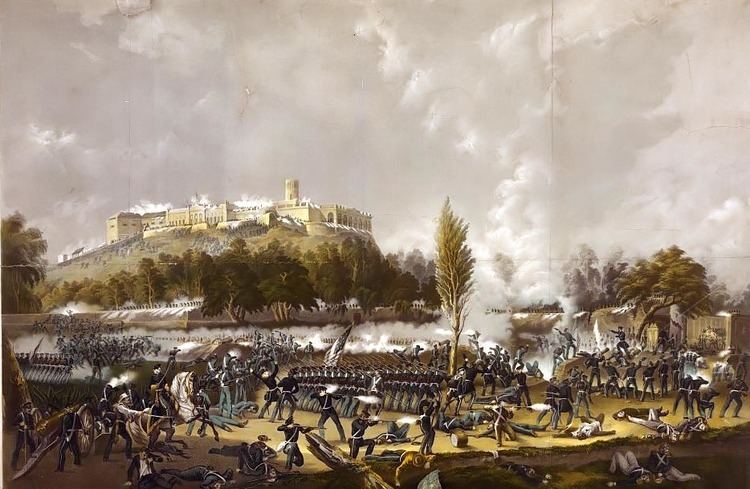 | ||
9,000 880 total250 10th Infantry115 Querétaro Battalion277 Mina Battalion211 Union Battalion27 Toluca Battalion 130 killed703 wounded29 missing 600-675 killed200-? wounded200-? captured Combatants Mexico, United States of America Similar Mexican–American War, Battle of Molino del Rey, Battle of Churubusco, Battle of Cerro Gordo, Battle of Contreras | ||
The battle of chapultepec and others
The Battle of Chapultepec in September 1847 was a battle between the invading US army and Mexican forces holding Chapultepec wounded in Mexico City during the Mexican-American War as part of the Battle for Mexico City. The castle, sitting atop a 200-foot (60 m) tall hill, was an important position for the defense of the city. Its capture paved the way for the fall of Mexico City.
Contents
- The battle of chapultepec and others
- Battle of chapultepec
- Background
- Battle
- Los Nios Hroes
- Saint Patricks Battalion
- Beln and San Cosm Gates
- Aftermath
- Legacy
- Additional Reading
- References

Battle of chapultepec
Background
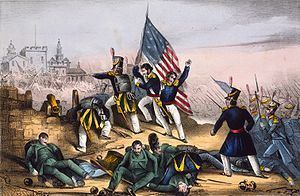
On September 8, 1847, in the costly Battle of Molino del Rey, U.S. forces had managed to drive the Mexicans from their positions near the base of Chapultepec Castle guarding Mexico City from the west. However, Army engineers were still interested in the southern causeways to the city. General Winfield Scott held a council of war with his generals and engineers on September 11. Scott was in favor of attacking Chapultepec and only General David E. Twiggs agreed. Most of Scott's officers favored the attack through the southern gates, including Captain Robert E. Lee. A young lieutenant, P. G. T. Beauregard, gave a textbook speech that persuaded General Franklin Pierce to change his vote in favor of the western attack.
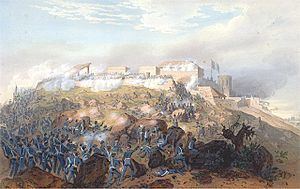
Antonio López de Santa Anna was in command of the army at Mexico City. He understood that Chapultepec Castle was an important position for the defense of the city. The castle sat atop a 200-foot (60 m) tall hill which in recent years was being used as the Mexican Military Academy. General Nicolás Bravo, however, had fewer than 1,000 men (832: Total including 250: 10th Infantry, 115: Querétaro Battalion, 277: Mina Battalion, 211: Union Battalion, 27: Toluca Battalion and 42: la Patria Battalion with seven guns( Gen. Manuel Gamboa with 2-24 lbs, 1-8 lb., 3-4 lbs. & 1 howitzer (68) ) to hold the hill, including 200 cadets, some as young as 13 years old. A gradual slope from the castle down to the Molino del Rey made an inviting attack point.
According to military records at the General National Archives in Mexico City, Chapultepec Castle was only defended by 400 men, 300 from de Batallón de San Blas under the command of Lieutenant Colonel Felipe Xicoténcatl, and the castle's garrison of 100 men, including the cadets. The additional Mexican troops were used in external walled redoubts of the castle to protect a large rectangular piece of ground in front of the castle itself. This area was protected by high walls and was about three-quarters of a mile long by one-quarter mile deep. This area was critical to the defense of the castle because the slope of the hill from the west was so gentle, it also encompassed the southern slopes which were moderate compared to the steep escarpments on the east and north. Also the source of water for the castle was located within this area.
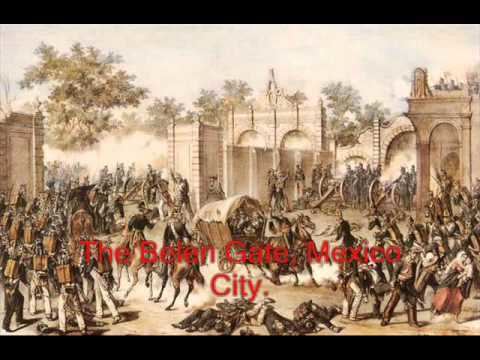
Scott organized two storming parties. The first party consisted of Captain Samuel Mackenzie's 256 men and Gideon Pillow's division, who would advance from the Molino east up the hill. The second storming party consisted of Captain Silas Casey's men and John A. Quitman's division, advancing along the Tacubaya road. However, Casey was replaced by Major Levi Twiggs. Only Twiggs' division and Bennett Riley's brigade were left on the American right flank.
Battle
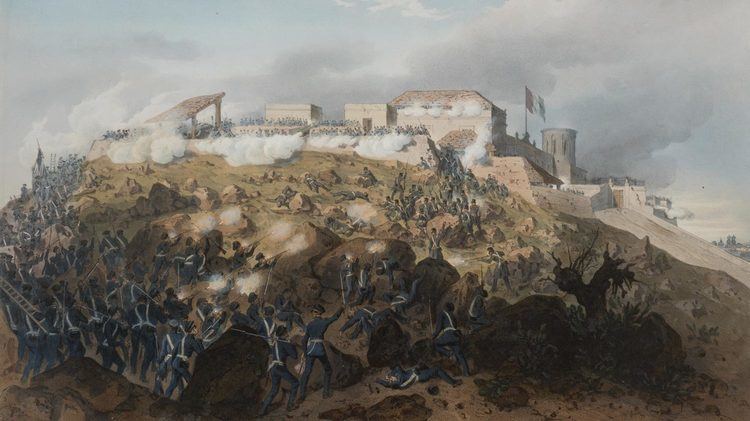
The Americans began an artillery barrage against Chapultepec at dawn on September 12. It was halted at dark and resumed at first light on September 13. At 8 AM, the bombardment was halted and General Scott ordered the infantry attack. There were three assault columns. On the left were the 11th and 14th Infantry under Colonel William Trousdale moving east along the Anzures aqueduct, in the center were four companies of the Voltigeur regiment under Colonel Timothy Patrick Andrews along with the 9th and 15th Infantry moving through the swamp and western edge of the grove, and on the right were the remaining four Voltigeur companies under Lieutenant Colonel Joseph E. Johnston.
Pillow was quickly hit in the foot and called for reinforcements, which came from John A. Quitman's division but the attack faltered when fired upon by the Moelia Battalion battery. Andrews's column cleared the grove of Mexican troops and linked up with Johnston. Yet, the attack by the 9th and 15th Infantry stalled waiting for scaling ladders, and Col. Truman B. Ransom was killed.
Quitman sent Persifor Smith's brigade to his right and brought in James Shields, plus the New York and 2d Pennsylvania Regiments into the assault. At the same time, Newman S. Clarke's brigade arrived on the western slope, as did the scaling ladders. The Voltigeurs soon planted their flag on the parapet.
By 9 AM, General Bravo surrendered to the New York Regiment and the American flag flew over the castle. Santa Anna watched the Americans take Chapultepec while an aide exclaimed "let the Mexican flag never be touched by a foreign enemy". He also exclaimed, "I believe if we were to plant our batteries in Hell the damned Yankees would take them from us."
Los Niños Héroes
During the battle, five Mexican military cadets plus one of their instructors, refused to fall back when General Bravo finally ordered retreat and fought to the death. These were teniente (lieutenant) Juan de la Barrera and cadets Agustín Melgar, Juan Escutia, Vicente Suárez, Francisco Márquez and Fernando Montes de Oca, all between the ages of 13 and 19. According to legend, the last of the six, Juan Escutia, grabbed the Mexican flag, wrapped it around himself and jumped off the castle point to prevent the flag from falling into enemy hands. In 1967, Gabriel Flores painted a mural depicting "Los Niños Héroes".
A mural decorates the ceiling of the palace, showing Juan Escutia wrapped in the flag, apparently falling from above. A monument stands in Chapultepec Park commemorating their courage. The cadets are eulogized in Mexican history as Los Niños Héroes, the "Child Heroes" or Heroic Cadets.
Saint Patrick's Battalion
Thirty men from the Saint Patrick's Battalion, a group of former United States Army soldiers who joined the Mexican side, were executed en masse during the battle. They had been previously captured at the Battle of Churubusco. Colonel William S. Harney specified that they were to be hanged with Chapultepec in view and that the precise moment of their death was to occur when the U.S. flag replaced the Mexican tricolor atop the citadel.
Belén and San Cosmé Gates
General Scott arrived at the castle and was mobbed by cheerful soldiers.
William J. Worth's division was sent by Scott to support Trousdale's men on La Verónica Causeway (now Avenida Melchor Ocampo) for the main attack against the San Cosme Gate. Defended by Gen. Rangel's Granaderos Battalion, part Matamoros, Morelia & Santa Anna Battalions (Col. Gonzalez), part 3d Light (Lt. Col. Echeagaray), & 1st Light (Comdt Marquez) Trousdale, followed by John Garland's, Newman Clarke's and George Cadwalader's brigades, began advancing up the causeway.
General Quitman quickly gathered the troops in Chapultepec, except the 15th Infantry who guarded the castle and prisoners, and designed as a feint, headed down the Belén Causeway stopping at the Belen Garita. The gate was manned by the Morelia Battalion, under the command of General Andrés Terrés' (three guns and 180 men : 2d Mexico Activos) and the paseo to the north by General Ramirez. Troops began to desert, and when Terres ran out of ammunition, he withdrew into the Ciudadela. Led by the Mounted Rifles (fighting on foot), Quitman breached the Belén Gate at 1:20 p.m. General Scott later commented "Brave Rifles, you have gone through fire and come out steel".
It was 4 p.m. by the time Worth started his advance down the San Cosme causeway, having fended an attack by Torrejon's 1,500 cavalry. Garland's brigade used the arches of the aqueduct to advance on the right. Clarke's men on the right passed through a tunnel made by sappers. Lieutenant Ulysses S. Grant, and some 4th Infantry, used the bell tower of San Cosme Church south of the causeway to place a mountain howitzer. On the north side of the road, naval officer Raphael Semmes repeated Grant's successful maneuver. Lieutenant George Terrett then led a group of Marines behind the Mexican defenders and, climbing to the roof, unleashed a deadly volley on the artillery gunners. By 6 p.m., Worth had broken through the gate, and the defenders scattered, many retreating into the Ciudadela, sweeping Santa Anna along with them. As night fell, Worth lobbed five mortar rounds into the city which fell near the National Palace.
Aftermath
The city was yet to be taken, Santa Anna had 5,000 troops in the Ciudadela and 7,000 in other parts of the city. Yet, six of his generals were taken prisoner. At 1 AM the next day, he ordered a withdrawal to Guadalupe Hidalgo while the city authorities appeared at Scott's headquarters at 4 AM. By 7 AM the American flag was flying over the Ciudadela.
Legacy
The efforts of the U.S. Marines in this battle and subsequent occupation of Mexico City are memorialized by the opening lines of the Marines' Hymn, "From the Halls of Montezuma..." .
Among the lower-ranking officers present, many became generals in the upcoming American Civil War including Daniel H. Hill, Ulysess Grant, George Pickett, James Longstreet, Thomas Jackson (Stonewall Jackson), and Robert E. Lee.
Marine tradition maintains that the red stripe is worn on the trousers of the Blue Dress uniform, commonly known as the blood stripe, because all of the Marine NCOs and officers of the detachment died while storming the castle of Chapultepec in 1847, though iterations of the stripe predate the war. In 1849, the stripes were changed to a solid red from dark blue stripes edged in red, which dated from 1839.
In 1947, President Harry S. Truman laid a wreath on the Cadets Monument as a gesture of goodwill after Mexico aided the U.S. in World War II.
